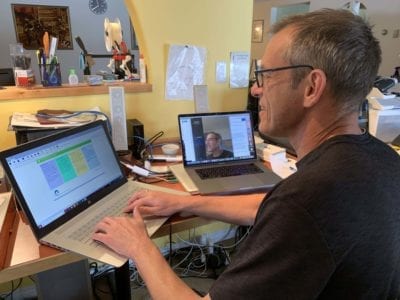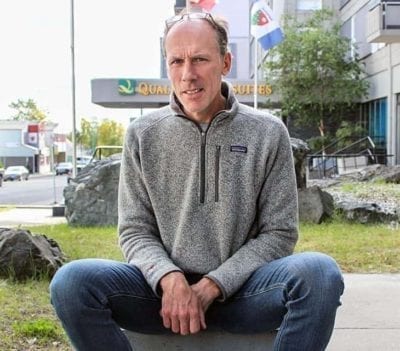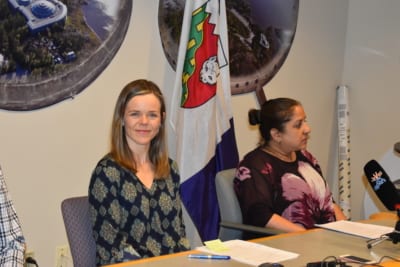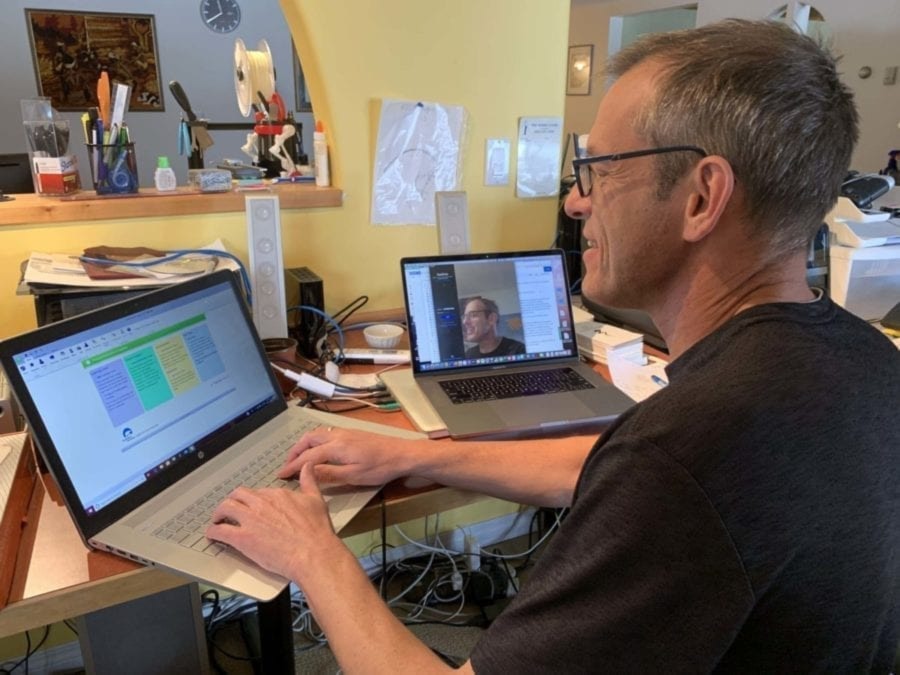The Covid-19 pandemic has left many patients in isolation and unable to visit their health-care providers in a personal setting, but many doctors and specialists see a new era for virtual health care as a result.
Dr. Sarah Cook, the territory's medical director, said she's excited for the potential to expand virtual health care in the NWT to allow patients and practitioners to consult through consumer video apps like Zoom, WhatsApp, Facetime or Skype.
The pandemic and the need to maintain self-isolation and physical distancing has increased the demand and awareness of virtual health care.

photo courtesy of the Department of Health and Social Services
"We've always done phone consultation in the Northwest Territories but we've really ramped virtual care up since the pandemic started and we've also added the option of video encounters," Cook explained. "The reason why this is so important is because it's allowing us to provide care to patients while maintaining physical distance. It enables people to have care from home, and not come into health care facilities where there might be an increased risk of viral transmission."
The GNWT has had forms of tele-health service since 1998, often accessing doctors and specialists in the south from health centres in the NWT via phones or monitors. What's different with virtual care is that patients can be tended to without having to go into a health-care facility -- they can do it through their own devices from the comfort of their own homes.
Cook said patients interested in the service are asked to make appointments through their doctor's office, as normal. Patients can then identify the app that they prefer to use if it's determined that virtual care is needed.
Physicians are provided GNWT-approved devices, so it would never be a practitioner's personal device in use.
Dr. Eugene Landsbergen, a family physician and travelling locum based in Sundre, Alta., has provided regular health services in Fort Providence and Fort Simpson for the past two years. Since the pandemic started last month, he has been using virtual health care with Facetime for family doctor checkups, preventative care, examining infectious illnesses and colds, gastrointestinal care and emergency treatments, among others. He recently conducted an entire clinic virtually from Alberta to assist patients in Fort Providence, avoiding travel into the NWT and threatening the spread of the virus.

NNSL file photo
"I had never done it before and it had always been in person," Landsbergen said of virtual care during the pandemic. "I think in time we will have to go physically again but, for the moment, because people know me, it was kind of pleasant to meet in this bit of an unorthodox way. It was pleasant to greet patients and see the connection we still had even if it was virtual."
However, Landsbergen said there have been instances where he has found that virtual care can have challenges involving poor connectivity and image quality.
"With the skin, for example, looking at a (skin) rash, it's hard to do, and your physical exam capacities have to be relayed through a registered nurse that does the exam -- and certain exams are easier to do for a physician than for an RN on the ground," he said.
Overall, Landsbergen sees virtual care as a positive trend coming from the pandemic experience.
"I think, like with every crisis, something good might come out of it and I think more virtual care that's being recognized and being allowed by the college of physicians and surgeons is a good thing in order to save some healthcare dollars and save patients' valuable time."
Beyond family physicians
Cook said the benefit of the service goes beyond family physicians as specialists and sub-specialists have made use of the service as well, including occupational health therapists, speech language pathologists and physiotherapists.
In the last two weeks of March, the GNWT's rehabilitation team provided 227 phone appointments as well as 50 telehealth appointments and 20 video sessions across the territory, she said.
While the service adds convenience for the patient, Cook said she has also received positive feedback from practitioners in recent weeks. It turns out that virtually observing the home environment of a patient can help the practitioner increase the quality of health care.
"Speech language pathologists, for example, have been able to observe their clients in their own natural settings," she said. "If they're observing children and their speech patterns, they've been able to see how they interact with their own parents, their siblings their pets in their own environment."
Likewise, occupational therapists have been able to assist patients better analyze how specific pieces of furniture impact their health, while physiotherapist have been able to help adapt exercises in a person's home, Cook said.

NNSL file photo
Privacy concerns
Cook acknowledged that there are downsides to the medical technology, particularly the concern of privacy breaches with apps. Currently the territory is allowing for virtual health care to be done by unregulated apps and these risks are explained to patients so that they understand their privacy information could be breached, but this will change, said Cook.
"Using unregulated apps is not a long-term solution by any means and we recognize that there there are those privacy concerns," she said.
"In the territory, we will need to make a decision going forward as well as which regulated app makes the most sense to us, but for now we're enabling people to use any of these unregulated apps, just because it's so, so important that we enable virtual care to reduce people having to be present in person and reduce people having to travel for appointments as well."
Dr. Ewan Affleck, a longtime Yellowknife physician, co-chaired a Canada Virtual Task Force on behalf of the College of Family Physicians and Surgeons and in conjunction with the Canadian Medical Association and the Royal College of Physicians and Surgeons of Canada. In February the task force released a report stating that Canada has to improve virtual care. Among its recommendations include eliminating barriers to virtual care; improving legislation, policy and education matters around its promotion; and improving the overall health infrastructure for information to be exchanged by virtual means.
"While the majority of Canadian physicians’ offices and health-care facilities are now using some form of electronic record keeping and a majority of households have internet access, there remains in Canada a large deficit in the ability to use electronic means to exchange health information across delivery points and to provide publicly insured care," the study states.
